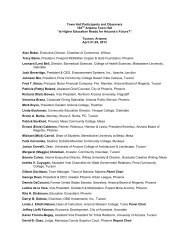Background Report - Arizona Town Hall
Background Report - Arizona Town Hall
Background Report - Arizona Town Hall
Create successful ePaper yourself
Turn your PDF publications into a flip-book with our unique Google optimized e-Paper software.
Cristina Cárdenas was born in Guadalajara, Jalisco, Mexico, where she studied architecture at<br />
the Instituto Tecnológico de Estudios Superiores de Occidente (ITESO). Cárdenas<br />
pursued further training at the Universidad de Guadalajara under Francisco Caracalla and<br />
Jorge Martínez, former assistants to muralist José Clemente Orozco. Her draftsmanship,<br />
iconography, artistic forms, color, and styles are derived from Mexican neo-figurative<br />
expressionism in combination with the academic training she received in the United States,<br />
where she studied painting and printmaking with Luis Jimenez, Robert Colescott, Bruce<br />
McGrew, and Bailey Doogan at the University of <strong>Arizona</strong>. Cárdenas earned a Master of Fine<br />
Arts degree in printmaking in 1990, and has lived and worked in Tucson for over two decades.<br />
Her large and small-scale paintings, lithographs, and monoprints disrupt stereotypes<br />
of gender, religion, and culture. More recently she has incorporated photographs and digital<br />
images of historical subjects and self-portraits in works on fine art paper and wood panel<br />
surfaces. For the last decade, she has also used bark/amate paper produced by the Otomi<br />
Indians of San Pablito, Puebla, Mexico. A textured bark paper made using pre-Hispanic<br />
methods, amate provides a historical link to her Mexican indigenous roots. Cárdenas<br />
combines amate with assorted media such as acrylic and gouache paints, dry pigments, gold<br />
leaf, and printmaking techniques. She uses modern techniques on ancient surfaces to create<br />
new representations of female archetypes derived from classical Mexican antiquity,<br />
contemporary interpretations of female saints, and intimate (auto)biographical portraits of<br />
womanhood and motherhood. Her work also explores the experience of unnamed or unknown<br />
immigrant subjects from the perspective of a woman artist born in Mexico who lives in a<br />
border zone. Her art engages the simultaneous challenges of belonging to a cultural<br />
community and forming an individual identity.<br />
D. Bryon Darby has been photographing the ever-changing landscape of the West for the<br />
past decade. A life-long inhabitant of the desert, Bryon was raised in Northern Utah where he<br />
received a Bachelor of Fine Arts in graphic design from Utah State University. Since completing<br />
his undergraduate degree in the spring of 2001, Bryon has supported himself as a<br />
commercial artist in the advertising and editorial fields. Presently, he is working on a public<br />
art commission with the Phoenix Office of Cultural Affairs while finishing his Master of Fine<br />
Arts in Photography at <strong>Arizona</strong> State University. His current work explores ideas about the<br />
power of place on personal experience while expanding on notions of culture and landscape.<br />
Janet Echelman reshapes urban airspace with monumental, fluidly moving sculpture that<br />
responds to environmental forces including wind, water, and sunlight. In 2010, she premiered<br />
Water Sky Garden at the Vancouver Olympic Winter Games, and in 2009, she completed the<br />
largest public art commission in the United States that year, Her Secret is Patience, in<br />
Phoenix. This sculpture was recognized by a Public Art Network, Year in Review Award that<br />
same year. Her art has been presented in Spain, Italy, Portugal, Lithuania, India, Japan,<br />
Indonesia, Hong Kong, Canada, Mexico, and the United States. She graduated from Harvard<br />
and completed graduate degrees in psychology and painting. About the art work: Suspended<br />
above the two-city-block Civic Space Park, the sculpture is monumental yet soft, fixed in<br />
place but constantly in motion, it dances gently in the air, choreographed by the flux of desert<br />
winds. The large three-dimensional multi-layered net form is created by a combination of<br />
hand-baited and machine-loomed knotting, and is the result of a collaborative effort with an<br />
international team of award-winning aeronautical and mechanical engineers, architects,<br />
Appendix | 243




